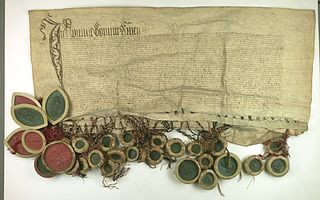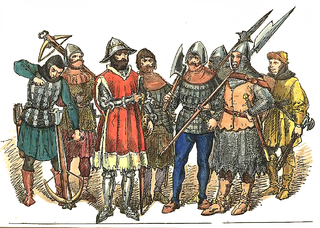
The Prussian Confederation was an organization formed on 21 February 1440 at Kwidzyn by a group of 53 nobles and clergy and 19 cities in Prussia, to oppose the arbitrariness of the Teutonic Knights. It was based on an earlier similar organization, the Lizard Union established in 1397 by the nobles of Chełmno Land.

Warmia is both a historical and an ethnographic region in northern Poland, forming part of historical Prussia. Its historic capitals were Frombork and Lidzbark Warmiński and the largest city is Olsztyn.

The Peace of Thorn or Toruń of 1466, also known as the Second Peace of Thorn or Toruń, was a peace treaty signed in the Hanseatic city of Thorn (Toruń) on 19 October 1466 between the Polish king Casimir IV Jagiellon and the Teutonic Knights, which ended the Thirteen Years' War, the longest of the Polish–Teutonic Wars.

Frombork is a town in northern Poland, situated on the Vistula Lagoon in Braniewo County, within Warmian-Masurian Voivodeship. As of December 2021, it has a population of 2,260.

Braniewo, is a town in northern Poland, in Warmia, in the Warmian-Masurian Voivodeship, with a population of 16,907 as of June 2021. It is the capital of Braniewo County.

Royal Prussia or Polish Prussia became a province of the Crown of the Kingdom of Poland, which was annexed following the imposed Second Peace of Toruń (1466) from territory in Pomerelia and western Prussia which had been part of the State of the Teutonic Order. Royal Prussia retained its autonomy, governing itself and maintaining its own laws, customs, rights and German language for the German minority and Polish language for the Polish majority.

The Prussian Homage or Prussian Tribute was the formal investiture of Albert, Duke of Prussia (1490-1568), with his Duchy of Prussia as a fief of the Kingdom of Poland that took place on 10 April 1525 in the then capital of Kraków, Kingdom of Poland. This ended the rule of the Teutonic Order in Prussia, which became a secular Protestant state.

Lidzbark Warmiński, often shortened to Lidzbark, is a historical town located within the Warmian-Masurian Voivodeship, in northern Poland. It is the capital of Lidzbark County.

Dobre Miasto is a town in Poland, in the Warmian-Masurian Voivodeship with 9,857 inhabitants as of December 2021. It is situated in the northwestern part of the Masurian Lake District in the heart of the historical region of Warmia. It is also the seat of Dobre Miasto Commune which consists of the main town and 21 village administrative divisions, with a total population of 16,014.

Warmians were a Prussian tribe that lived in Warmia, a territory which now mostly forms part of the Warmian-Masurian Voivodeship in Poland, with a small northern portion located in neighbouring Russia. It was situated between the Vistula Lagoon, Łyna and Pasłęka Rivers.

Lucas Watzenrode the Younger was Prince-Bishop of Warmia (Ermland) and patron to his nephew, astronomer Nicolaus Copernicus.
Nicolaus von Tüngen was bishop of Warmia from 1467 until 1489.

Orneta is a town in northern Poland, with a total population of 8,951 (2016). It is situated in the Warmian-Masurian Voivodeship and within the historical region of Warmia.

Martin Truchseß von Wetzhausen zu Dachsbach was the 34th Grand Master of the Teutonic Knights, serving from 1477 to 1489.

Heinrich Reffle von Richtenberg was the 33rd Grand Master of the Teutonic Order, serving from 1470 to 1477.
This is the 1519-1521 Polish-Teutonic War. For a list of all Polish-German Wars, see Polish-German Wars.

Polish–Teutonic Wars refer to a series of conflicts that took place between the Kingdom of Poland and the Teutonic Order, a medieval German military order with roots in the Baltic region. These wars occurred primarily during the 14th and 15th centuries and were characterized by territorial disputes, political maneuvering, and religious differences.

The Archdiocese of Warmia is a Latin Church Metropolitan archdiocese of the Catholic Church in the Warmian-Masurian Voivodeship, Poland.

This is the 1454-1466 Polish-Teutonic War. For a list of all Polish-German Wars, see Polish-German Wars.

The Prince-Bishopric of Warmia was a semi-independent ecclesiastical state, ruled by the incumbent ordinary of the Warmia see and comprising one third of the then diocesan area. The Warmia see was a Prussian diocese under the jurisdiction of the Archbishopric of Riga that was a protectorate of the Monastic state of the Teutonic Knights (1243–1464) and a protectorate and part of the Kingdom of Poland—later part of the Polish–Lithuanian Commonwealth (1464–1772), confirmed by the Peace of Thorn in 1466. The other two thirds of the diocese were under the secular rule of the Teutonic Knights until 1525 and Ducal Prussia thereafter, both entities also being a protectorate and part of Poland from 1466.




















